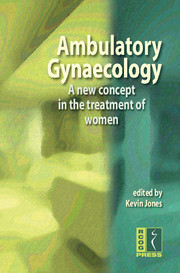Book contents
- Frontmatter
- Contents
- ABOUT THE AUTHORS
- ABBREVIATIONS
- PREFACE
- Chapter 1 Introduction
- Chapter 2 Anaesthesia and analgesia for outpatient gynaecology
- Chapter 3 Colposcopy services
- Chapter 4 Abnormal uterine bleeding
- Chapter 5 Endometrial ablation
- Chapter 6 Urogynaecology: urinary incontinence and genital prolapse
- Chapter 7 Infertility
- Chapter 8 Early pregnancy units and emergency gynaecological services
- Chapter 9 Pelvic utrasound and interventional radiology
- Index
Chapter 9 - Pelvic utrasound and interventional radiology
Published online by Cambridge University Press: 05 June 2014
- Frontmatter
- Contents
- ABOUT THE AUTHORS
- ABBREVIATIONS
- PREFACE
- Chapter 1 Introduction
- Chapter 2 Anaesthesia and analgesia for outpatient gynaecology
- Chapter 3 Colposcopy services
- Chapter 4 Abnormal uterine bleeding
- Chapter 5 Endometrial ablation
- Chapter 6 Urogynaecology: urinary incontinence and genital prolapse
- Chapter 7 Infertility
- Chapter 8 Early pregnancy units and emergency gynaecological services
- Chapter 9 Pelvic utrasound and interventional radiology
- Index
Summary
Introduction
Pelvic ultrasound scanning has a pivotal role in the provision of one-stop gynaecology services. It is particularly important for abnormal uterine bleeding (Chapter 4), infertility (Chapter 7) and early pregnancy complications (Chapter 8). It is also the primary diagnostic tool for the investigation of acute pelvic pain in the emergency gynaecology unit.
Transvaginal ultrasound scan
A natural extension of the gynaecological examination, a transvaginal ultrasound scan (TVUS) should be used to confirm or exclude a diagnosis that is suspected on the basis of clinical findings. It is one of the least invasive diagnostic tools available. The transvaginal probe (5-7.5 MHz) produces a high-resolution image of the pelvic organs, providing reliable, reproducible information without the need for a full bladder.
TVUS has had a major impact on gynaecological practice. It is the investigative tool of choice for triaging women with pelvic pain into appropriate treatment protocols, thus enabling the clinician to avoid surgery in some cases and select the best surgical approach in others. With the use of TVUS, common gynaecological pathology of the pelvic organs may be diagnosed with confidence. In the presence of a negative pregnancy test and a normal pelvic examination, a normal ultrasound scan gives reassurance that the risk of notable pelvic pathology is small.
Provision of a TVUS facility as part of an outpatient or emergency assessment makes sense for both doctor and patient. The doctor can relate their scan findings directly to the history and examination that preceded the scan.
- Type
- Chapter
- Information
- Ambulatory GynaecologyA New Concept in the Treatment of Women, pp. 106 - 119Publisher: Cambridge University PressPrint publication year: 2008

